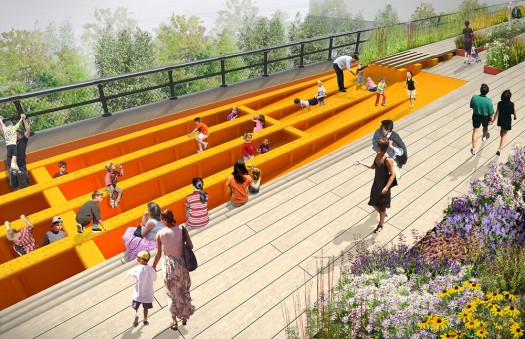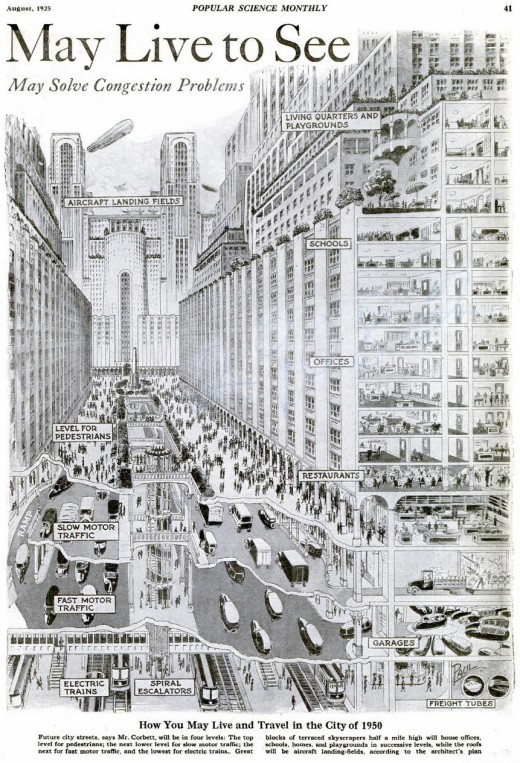
We are celebrating 15 years — and counting — of stories that are deeply researched and deeply felt, that build a historical record of what the city has been.
We are celebrating 15 years — and counting — of stories that are deeply researched and deeply felt, that build a historical record of what the city has been.

In line with previous design strategies on the High Line, designers propose coating the existent steel beams with rubber to create a designated children’s play space.
HIGH LINE PHASE THREE
Renderings of the initial designs for the third and final section of the High Line were released this week. The new leg of the park will include children’s play space (including “peel-up” see-saws and a climbing space embedded into the structure’s beams and girders), a 70-foot-tall passage under the future Hudson Yards Tower C, and more open space courtesy of the 10th Avenue Spur. The designs of the first two sections have focused on the existing context of the city, giving users privileged views of the city around them, over the Hudson, onto the streets below and even into nearby apartments. But planning for the rail yards section presents the designers, Field Operations and Diller Scofidio + Renfro, with a new challenge: designing a park to weave around an entirely new neighborhood that has barely been proposed, let alone built. The designers’ proposed solution is to create an “interim walkway” along the west side of the Rail Yards, where visitors can see the original railroad tracks and enjoy views of the river during the phased construction. For more information, see the High Line Blog and Co.Design.
QUINN ON DESIGN
In the past decade, the design industries have seen unprecedented growth in New York City, as we saw last June when we spoke to David Giles about the Center for an Urban Future’s Growth by Design study. Either the Bloomberg administration has actively put an emphasis on designing New York City’s urban landscape not seen since the Lindsay administration, or Bloomberg has coincidentally been the mayor during a huge boom in the city’s interest in designing its own landscape. Whichever scenario more accurately describes Bloomberg’s tenure, the future of the design industries in New York City is less certain with Bloomberg’s end in sight. City Council Speaker Christine Quinn, a potential mayoral candidate, outlined a proposal for a new New York City Design Week in last month’s State of the City address. This week, The Architect’s Newspaper‘s William Menking devoted an editorial to calling for more from our next administration, asking “Really, is a week-long design festival the best that the Speaker can do to support and encourage this dynamic sector of the city’s economy?” Read the full speech here, and Menking’s editorial here.

“How you may live and travel in the city of 1950″ c.1925 | via Retronaut.
WHEN THE FUTURE WAS 1950
Speculation about the future city has never failed to fill sketchbooks and captivate imaginations. From 2012 visions of land bridges creating new neighborhoods to 1969 imaginings of transit networks that would remove automobiles from streets, here on Urban Omnibus we have done our fair share of contemplating what the urban landscape might look like, or might have looked like, through the eyes of creative thinkers and planners. This week, Retronaut (found via The Guardian‘s data blog) resurfaced architect Harvey W. Corbett’s vision of the future from the August 1925 Popular Science Monthly, seen above. Corbett, who was the president of the Architectural League at the time, imagined a future where “buildings will be half a mile high or more,” where upper floors “will be reached by spiral escalators and will be supplied with pure air piped from the country.” Congestion and overcrowding would be a thing of the past, as would the streetcar and the elevated railway, thanks to four (or more) levels of streets for pedestrians, traffic of different speeds and electric trains. See Corbett’s vision, “The Wonder City You May Live to See,” and the entire August 1925 issue of Popular Science Monthly on Google Books.
ARTS FOR TRANSIT APP
Back in November we sat down with Sandra Bloodworth to talk about Arts for Transit. The program has brought some amazing artists’ work to the MTA network (Elizabeth Murray, Al Held, Sol Lewitt, Vito Acconci, Roy Lichtenstein, Laura Battle, Maya Lin, Mary Miss, George Trakas, to name but a few). But in a network with so much area, spanning across neighborhoods, boroughs, and into the far reaches of the suburbs, it isn’t always easy to find the artist’s work you’re looking for, or to identify the work of art that you’ve come to love as part of your morning commute. Arts for Transit has introduced a new smartphone app to help users, be they tourists or commuters, navigate their way to the 186 permanent works of art by subway line or an artist’s name. Download the app here and read more about it on Transportation Nation and in The New York Times.
BROOKLYN GRANGE AT NAVY YARD
The newest addition to the Brooklyn Navy Yard on its long journey towards redevelopment as a mixed-use waterfront development is Brooklyn Grange. The Long Island City-based commercial rooftop farm has unveiled plans for a new 45,000-square-foot installation atop the building adjacent to Flushing Avenue and Cumberland. Start-up costs will be taken care of by a City DEP grant, in response to the estimate that the farm will be able to absorb enough rainwater to keep more than one million gallons of sewage out of the East River annually. Find more coverage at The New York Post.
EVENTS and TO DOs
OSAP CALL FOR PROPOSALS
The Open Space Alliance for Northern Brooklyn’s affiliate, OSA Presents (OSAP), is calling for proposals to transform a disused industrial site into a temporary music venue. OSAP is relocating its Williamsburg Waterfront concert series, formerly the McCarren Park Pool and East River State Park concerts, to an empty lot at 50 Kent Avenue in Williamsburg, Brooklyn, and they need an interim concert space. The jury will include Winka Dubbleldam (Archi-Tectonics), Sharon Matt Atkins (Brooklyn Museum), Nina Rappaport (Yale School of Architecture); Joe Amrhein (Pierogi, Boiler), artist Mark Fox, New York State Assembly Member Joseph Lentol, New York State Senator Daniel Squadron, Brooklyn Borough President Marty Markowitz, and New York City Councilmember Steve Levin. Registration ends March 20, 2012. Click here for the complete call for proposals.
WOMEN SHAPING OUR WORLD: ARCHITECTURE, GENDER, AND SPACE
At what point do discussions of gender and architecture intersect? In a time when the general public’s interest in architecture and design is growing, and women comprise over half of the architectural student population (though only 45% of female graduates go on to get licenses as opposed to the 73% of their male counterparts that get licensed), what does it mean to be a woman in architecture? This weekend at the Brooklyn Museum of Art, Susie Rodriguez, Anne Fougeron, Karen Stein, Toni Griffin, in a panel moderated by John Cary, will discuss social and political implications of their work and the role women play in shaping the culture at large. Saturday, March 17, 2pm, Elizabeth A. Sackler Center for Feminist Art, Forum, 4th Floor, Brooklyn Museum of Art. More info available here.
The Roundup keeps you up to date with topics we’ve featured and other things we think are worth knowing about
The views expressed here are those of the authors only and do not reflect the position of The Architectural League of New York.